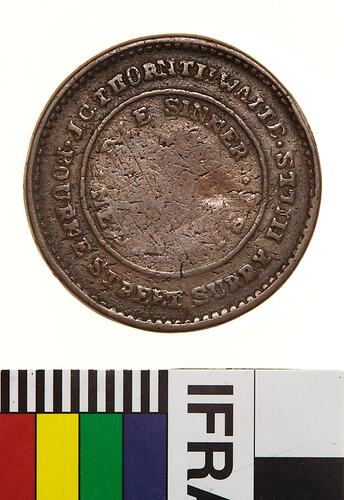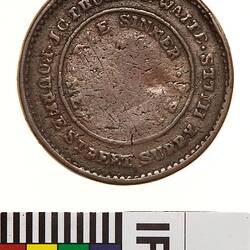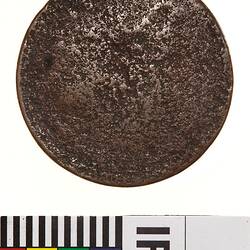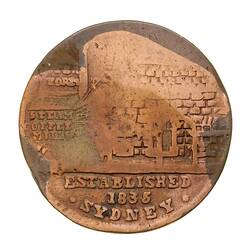Summary
Copper one Penny Token, minted and issued by J.C. Thornthwaite of New South Wales, in 1854. Thornthwaite was the first person to manufacture tokens and medals in Australia. Migrating to Sydney in 1849, his tokens are noteworthy for the lack of clarity of detail in design because the dies were not cut deep enough and he lacked the tools to produce high quality tokens. Thornthwaite also worked as a medallist, particularly after tokens were made illegal in NSW in 1868.
Previous Collections: National Gallery of Victoria
Physical Description
A round copper token (34 mm dia) featuring the name and buisness of the issuer, J.C. Thornthwaite, Die Sinker Medallist and an Arms of New South Wales supported by a kangaroo and emu badle struck up. The reverse requires careful examination to see the design.
Obverse Description
Within line circle, two roses; around which, . DIE SINKER . / [AND] / MED[ALLI]ST; around above, J.C.THORNTHWAITE; around below, . BOURNE STREET SURRY HILLS .
Reverse Description
Australian arms; around above, [ADVANCE AUSTRALIA]; below, 1854
Edge Description
Plain
More Information
-
Collecting Areas
-
Acquisition Information
Transfer from National Gallery of Victoria (NGV), 15 Mar 1976
-
Date Issued
1854 AD
-
Issued By
John Craven Thornthwaite, Surry Hills, Greater Sydney, New South Wales, Australia, 1854
-
Mint
John Craven Thornthwaite, Surry Hills, Greater Sydney, New South Wales, Australia, 1854
-
Previous Collection
Numismatics Collection, National Gallery of Victoria (NGV), pre 1976
-
Inscriptions
Obverse: J.C.THORNTHWAITE BOURNE STREET SURRY HILLS DIE SINKER [AND] MEDALIST Reverse: [ADVANCE AUSTRALIA] 1854
-
Denomination
-
Series
-
Material
Copper
-
Axis
07
-
Classification
-
Category
-
Discipline
-
Type of item
-
Dimensions
34 mm (Outside Diameter), 14.204 g (Weight)
-
Shape
Round
-
References
Note: This token was once considered to be of the uniface (Andrews 580). Careful examination however shows ther was a reverse. An example in the Dixon Library collection is the same as this. However the uniface type does occur, the private collector Ken Downie had one which I examined at the time of his sale and could see no reverse details. John Sharples.
[Book] Andrews, Arthur. 1921. Australasian Tokens and Coins., No. 579
[Book] Heyde, Gilbert C. & Skinner, Dion H. 1967. Unofficial Coins of Colonial Australia and New Zealand., No. 251



